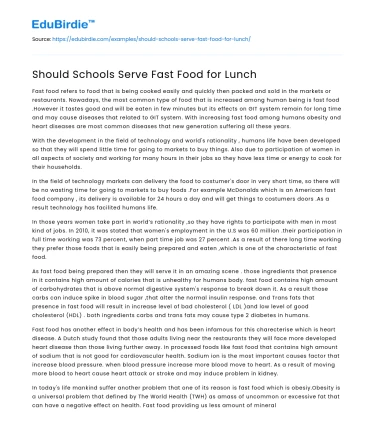Introduction
The inclusion of fast food in school lunch programs has ignited a heated debate among educators, nutritionists, and policymakers. On one hand, fast food is often criticized for its high caloric content, excessive sodium levels, and lack of essential nutrients. On the other hand, it presents a convenient and popular meal option that aligns with the preferences of many students. The decision to serve fast food in schools is not merely a question of convenience or preference, but one that also considers the broader implications on students' health, educational outcomes, and social behaviors. This essay explores the multifaceted dimensions of this issue, critically analyzing the potential benefits and detriments of incorporating fast food into school menus. By examining empirical evidence and expert opinions, the aim is to provide a balanced perspective that can inform future policy decisions regarding school nutrition.
Nutritional and Health Implications
One of the primary concerns regarding fast food in school lunch programs is its nutritional inadequacy. Fast food is typically high in calories, saturated fats, and sugars, while being low in essential nutrients such as fiber, vitamins, and minerals (Micha et al., 2017). The consumption of such food on a regular basis can contribute to a variety of health issues among students, including obesity, type 2 diabetes, and cardiovascular diseases (Ludwig, 2007). For instance, a study conducted by the National Institutes of Health found that children who frequently consume fast food are more likely to exhibit a higher body mass index (BMI) than their peers who consume it less often (Bowman et al., 2004). Consequently, schools have a responsibility to provide nutritious meals that support students' physical health and well-being.
Save your time!
We can take care of your essay
- Proper editing and formatting
- Free revision, title page, and bibliography
- Flexible prices and money-back guarantee
However, it is also essential to consider the context in which fast food is provided. Some schools have attempted to mitigate the negative health impacts by offering healthier fast food options, such as salads, grilled chicken, and whole-grain buns. This approach aims to balance students' preferences with nutritional requirements. Nevertheless, critics argue that even these modified options often fail to meet the Dietary Guidelines for Americans, which schools are required to follow (USDA, 2020). Therefore, while offering fast food may increase student satisfaction and participation in school lunch programs, it is crucial to ensure that these meals do not compromise students' long-term health.
Economic and Social Considerations
From an economic perspective, the integration of fast food into school lunch programs can offer both advantages and challenges. On the one hand, fast food is often more cost-effective than traditional school meals, allowing schools to allocate their budget more efficiently. A report by the School Nutrition Association indicated that some school districts have experienced reduced food costs by partnering with fast food vendors for certain meal components (SNA, 2019). This cost-saving measure can be particularly beneficial for schools in low-income areas, where budget constraints are a significant concern.
On the other hand, the adoption of fast food in schools might inadvertently promote unhealthy eating habits among students. The social influence of fast food branding and marketing can shape students' food preferences, potentially leading to a lifelong preference for processed and convenience foods (Harris et al., 2009). Moreover, the presence of fast food in schools can undermine educational efforts aimed at promoting healthy eating habits and nutrition literacy. Therefore, while the economic benefits of serving fast food are apparent, the potential social repercussions must be carefully evaluated to prevent detrimental impacts on students' dietary behaviors.
Educational Impact and Student Engagement
The role of fast food in school lunch programs extends beyond health and economics; it also influences educational outcomes and student engagement. Nutrition is closely linked to cognitive function and academic performance, with studies illustrating that well-nourished students exhibit better concentration, memory, and overall academic achievement (Florence et al., 2008). Schools that prioritize nutritious meals can thus play a pivotal role in enhancing students' educational experiences and success.
Fast food, if not carefully managed, could undermine these educational benefits. However, some argue that allowing fast food in schools could increase meal participation rates, leading to fewer hungry students and potentially reducing issues related to food insecurity (Gundersen & Ziliak, 2015). Schools could leverage this opportunity by incorporating educational components into their lunch programs, teaching students about balanced diets and nutrition while offering popular fast food choices. By transforming the school lunch experience into an educational opportunity, schools can foster a healthier relationship with food among students.
Conclusion
In conclusion, the decision to include fast food in school lunch programs is complex and multifaceted, requiring careful consideration of health, economic, social, and educational factors. While fast food can be a cost-effective and appealing option for students, its nutritional shortcomings and potential to instill unhealthy eating habits cannot be overlooked. Schools must strive to find a balance between providing meals that are both appealing and nutritious, ensuring that the well-being and educational success of students are not compromised. Ultimately, the goal should be to create an environment where healthy eating is both accessible and enjoyable, preparing students for a lifetime of healthy habits.
As schools continue to navigate the challenges of modern food service, it is imperative to engage with stakeholders, including parents, students, and health professionals, to develop lunch programs that reflect the diverse needs and values of the community. By doing so, schools can play a crucial role in shaping the dietary habits and health outcomes of future generations.






 Stuck on your essay?
Stuck on your essay?

